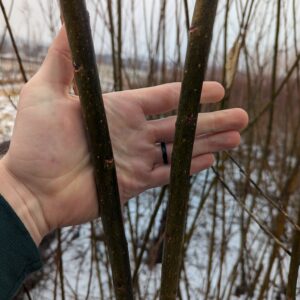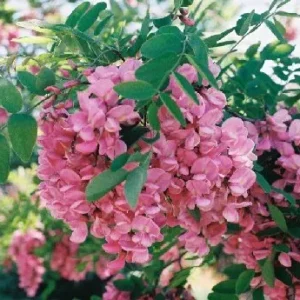I wrote a year ago about where we were at with propagation of improved honey locust, which you can read about here. Now I want to catch folks up on where we are with the nursery in general after another year of trials and experimentation.
Honey Locust
Let’s start with the honeys, since that’s what I get the most requests about.
First, we have planted 7,000 seedlings from the old Hershey plantings in our nursery, and are now culling all thorny trees. We will not take trees from the nursery and plant them out on projects until trees are at least 6’ tall, since at that point we’ll have good confidence that they are not thorny. (They could develop thorns at that size, but it is highly unlikely). We are also pruning the trees both for form and to give them as much encouragement to develop thorns as we can. If they have genetics for thorns, we want the tree to express that, so we can cull it early. At 6 feet plus our thornless trees will go from the nursery to silvopasture plantings, where they can then be observed for pod qualities in the years to come. We’ll primarily be selecting for high-yielding females with high sugar content in their pods, though some vigorous males will be retained as well for breeding efforts. Based on what we’ve seen from other plantings, where some honey locusts have started to yield in the 4th season from transplanting (5 years from seed), we anticipate we’ll be able to start this selection process in another 2-3 years.

While we wait for that process to yield us new selections, we are throwing all the other propagation methods at the wall to see what will stick. This year we confirmed that root cuttings can work very well for juvenile honey locust, but that the roots do indeed need to be quite young, and don’t regenerate as readily from roots taken from older trees. We took many root cuttings from thornless females with good pods, but none resprouted, which we suspect to be from a lack of juvenility. Meanwhile, we took a bunch of root cuttings from young seedlings and had very high success rates. We plan to refine this by testing the success rate of rootlings across a range of ages sourced from our projects.
We will also continue to graft trees, but likely only enough for our own projects. Given the marginal success rates we’ve seen with grafting honeys, it’s unlikely we’ll have many grafted honeys for sale in Fall 24/Spring 25. Grafting is our backup option as we are prioritizing more cost-effective and dependable methods of vegetative propagation.
In searching for those methods, we’ll be trying a number of techniques, including hardwood cuttings, softwood cuttings, and tissue culture. If any prove successful enough to be commercially viable, we will use those to scale clonal propagation of known cultivars such as Millwood and Calhoun.
At this point, my best guess as to when we’ll have sufficient quantities of improved honey locust that we’re able to sell to the public is Fall 25/Spring 26. I know that’s quite some time from now and you may have a grant to plant trees sooner. My advice is to focus on planting cheap, fast-growing, easy trees first, like black locust, poplar and willow, and integrating honey locust later on once the right stock is available.
Mulberry and Persimmon
The other two species we’re doing the most work with are mulberries and persimmon, given the tremendous upside for use in silvopasture. Both species have male and female plants, so what we aim to do is offer female, high-yielding trees that will drop during known timeframes. This will enable us to design systems with predictable feed drop all season long.
Mulberry has proven to be the easier one to propagate. We have had good success with softwood cuttings this year using a misting system. We have also gotten several cultivars into tissue culture, which is a big leap that will allow us to quickly expand production of mulberries. I keep diving into the available resources on mulberries, trying to estimate yield and nutritional quality, and the picture looks very, very good. Read here about the high protein content and quality amino acid profile of mulberry fruit, and here for estimates of mulberry yield based on the classic book Tree Crops by J. Russel Smith.
Meanwhile, persimmons have been a bit harder to propagate, but we’ve made some strides. Root cuttings from mature persimmon trees did better than those from mature honey locusts, indicating that root cuttings may be a very solid method once we are reliably able to source roots from known cultivars. We have also seen promising signs of persimmon via tissue culture.
We are aiming to open up for sales of both mulberry and persimmon by Fall 24/Spring 25.
Why not graft?
At this point some folks may be wondering why we’re going to all this trouble to find alternative propagation methods when all of these species can be grafted. The answer is that we want our trees to be as resilient and low-maintenance as possible. Grafted trees are at higher risk of failure due to the possibility of graft failure. That is an accepted risk if we were planting these trees into a nice orchard where the focus is on tree care. Instead, these trees will be planted into pastures, where the manager is focused on the livestock. Damage to trees should be expected and conditions will not be ideal for grafts. If a graft dies back to the roots, all you’re left with is a very expensive seedling tree without the traits of the grafted portion. We want our trees to be full clones from root to fruit.
Poplars and willows
This year we made a significant expansion to our propagation of willows and poplars, and now have over 12 acres dedicated to live-stake production. It’ll still be several more years before we can expect yields from those trees. The fact is that large poles are difficult to ship, which means we are actively encouraging folks throughout the country to develop live stake nurseries of their own and support the needs in their region. Read more here.
Other species
Most of our energy has been wrapped up in the above species, but there are more on our radar. We just haven’t had the bandwidth to pursue them much to this point. Thornless osage is something we’d like to propagate at scale, as well as ship-mast black locust. Once we get our top priority trees figured out, we’ll get working on oaks, hazelnuts, hickories and other hardwood with the qualities to thrive in silvopasture settings. That’s down the road a bit, and thankfully, there are plenty of quality trees already that will perform well in the meantime.
Thank you for following our progress and for your patience. Tree selection and propagation takes time. Our goal continues to be growing the best silvopasture-specific trees at a price that farmers can profitably implement at scale. We look forward to rolling out more and more trees in the years to come and seeing you take grazing to new heights.




